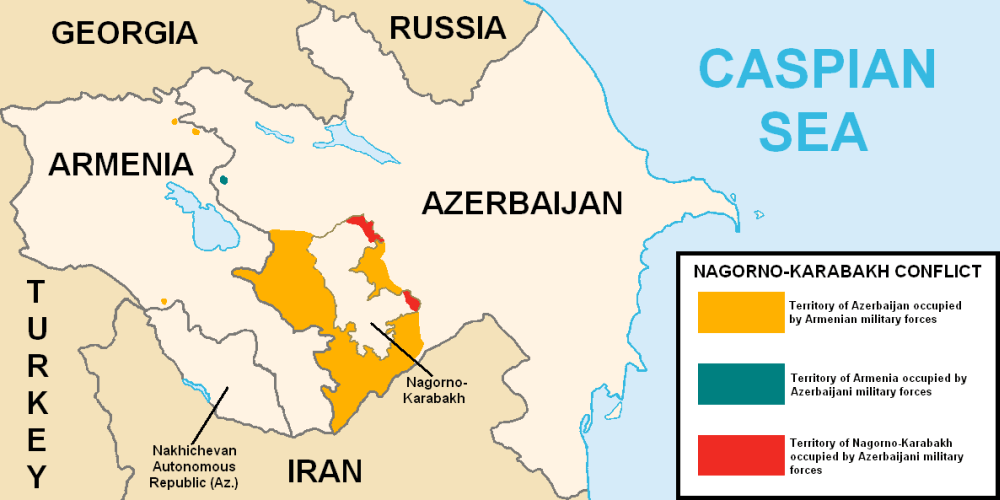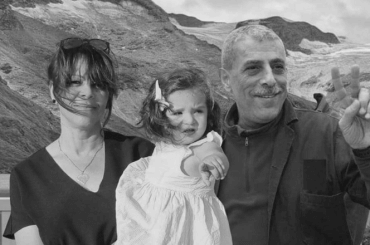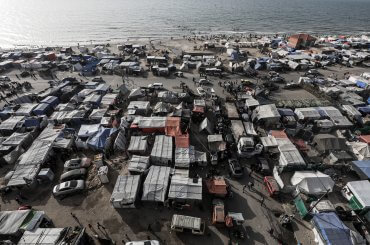Nagorno-Karabakh is a shambles. On September 27 hostilities flared up between Armenia and Azerbaijan in the breakaway enclave, located inside the borders of Azerbaijan yet populated by ethnic Armenians.
After three weeks of fighting and martial law the numbers of casualties differ massively, depending on the source, and are probably between a few hundred to several thousand killed. Around 75,000 ethnic Armenians fled their homes in Nagorno-Karabakh – more than half of the population. A tentative ceasefire has held since Sunday, replacing an earlier ceasefire from the previous week that fell apart within minutes.
Both Armenia and Azerbaijan are former Soviet republics. At that time Nagorno-Karabakh was an autonomous region and today the majority of its population claims independent status as the Republic of Artsakh. The mountainous region has its own president, prime minister and military force.

While Armenia does not claim the territory, it sees itself as the protector of the interest of the Armenians who live there and has previously militarily intervened on their behalf.
Monitors are still accessing fresh damage, although at the beginning of the month Amnesty International published a report confirming cluster bombs were used in civilian areas in Stepanakert.
“The use of cluster bombs in any circumstances is banned under international humanitarian law,” Denis Krivosheev said, Amnesty’s acting Head of Eastern Europe and Central Asia. “Their deployment in residential areas is absolutely appalling and unacceptable.”
The internationally banned munitions were identified by Amnesty as “Israeli-made M095 DPICM cluster munitions” and appeared “to have been fired by Azerbaijani forces.”
This heinous weapon is, rightly, outlawed in the Convention on Cluster Munitions by 110 countries; 13 others have signed but not ratified. Cluster munitions explode into dozens to hundreds of smaller bomblets filled with shrapnel, which then rain down to an area often larger than a football field. Up to 20% of the sub-munition does not explode, leaving whole areas as effective land mines for decades.
This fact raises the question of what role Israel, as an important regional power, actually plays in this war. Israeli journalists have questioned Israel’s ministry of defense and foreign affairs, but no Israeli official has provided a comment. Even so, Israeli arms sales to Azerbaijan have been widely documented.
From 2010 to 2019, the Stockholm International Peace Research Institute’s (SIPRI) Arms Transfers Database found Israel was the second-largest arms supplier to Azerbaijan, after Russia and far ahead of Belarus ranking third.
According to SIPRI, 25% of all weapons transfers to Baku in the past decade have come from Israel. Among them are drones, guided weapons, surface-to-air missiles, anti-tank missiles, and assault rifles. In the last five years, arms exports have increased dramatically with deliveries worth $740 million. From 2015 to 2019 a staggering 60% of arms sold and delivered to Azerbaijan came from Israel.
Close partners in weapons and oil trade
In a public appearance with Israeli Prime Minister Benjamin Netanyahu in December 2016, Azerbaijan’s President Ilham Aliyev boasted that he had purchased Israeli defense equipment worth “close to $5 billion” – a fairly significant sum in the face of Azerbaijan’s gross domestic product of around $38 billion. Israel is a major global arms exporter and has shipped weapon systems to 42 countries in the past five years according to SIPRI data. Of countries purchasing Israeli weapons, Azerbaijan ranks second behind India and purchases 17% of all Israeli arms exports.
Israel is by far the most important arms supplier to Azerbaijan, and Azerbaijan, in turn, is Israel’s second most important recipient.
A few days before the start of the most recent conflict, two Ilyushin Il-76 freighters from the Azerbaijani military landed at the Uvda military base in the Israel’s Negev desert. Based on flight data, Haaretz determined the visit was probably for “both the preparation and replenishing of Azerbaijani forces for the latest bout of fighting around the Nagorno-Karabakh enclave.”
Shortly after the beginning of the war, two more Azerbaijani cargo planes landed in the Negev. The Armenian leadership was indignant about the arms cooperation between Israel and Azerbaijan.
On October 1, Yerevan recalled its ambassador to Israel in protest, just two weeks after opening an embassy. Four days later, Israel’s President Reuven Rivlin calmed waves in a phone call with Armenia’s President Armen Sarkissian.
“In two or three days they seem to be on the way to stopping the supply of weapons,” Armenia’s ambassador Armen Smbatyan told the Armenian outlet Factor.am, as reported by the Times of Israel. “I was given a verbal promise,” by Rivilin, he said.
However, citing ongoing contracts, Israeli security analysts do not predict a change in planned weapons deliveries. Arms sales to Azerbaijan are just too important for Israel from both a strategic and an economic perspective.
As a high-tech and advanced industrial nation, Israel has immense energy needs. It is well known, however, that it has hardly any fossil fuels of its own and only produces minimally (although that could change in the future regarding newly discovered natural gas fields in the eastern Mediterranean). Azerbaijan, on the other hand, has abundant oil reserves and is an important regional producer.
Azeri oil exports to Israel began in 1999, and Baku quickly outperformed Israel’s then main exporters, Russia and Kazakhstan. According to data compiled by the MIT’s Observatory of Economic Complexity, Azerbaijan is by far Israel’s largest supplier of crude oil over the past ten years. In 2019, imports were worth $ 1.33 billion, representing 37% of Azerbaijan’s crude exports.
Countering Iran
Ethnic Azerbaijanis live on both sides of the Azerbaijan-Iran border. Tehran is known to be the protective power over Shiites and Azerbaijan is, along with Iran, Iraq, and Bahrain, one of a few countries in the world with a Shiite majority. Iran and Azerbaijan also share common oil and gas reserves in the Caspian Sea.
On the face of it, one could assume that both countries are strategic allies. But Iran backs Armenia, and Tehran and Baku are adversaries. There are historical and nationalistic reasons. About twice as many Azerbaijanis live in Iran as in Azerbaijan, including the Supreme Leader Ayatollah Ali Khamenei.
After the collapse of the Soviet Union, Tehran wanted to prevent the unification of all Azerbaijanis at all costs and nip the emergence of separatist tendencies in the northwest of the country in the bud. Baku relied entirely on Western corporations for its oil explorations in the Caspian Sea – U.S. ships directly off the Iranian coast. This cooperation manifested itself not least in the Baku–Tbilisi–Ceyhan pipeline through which Israel also receives its Azerbaijani oil.
On the other hand, Azerbaijan is closely integrated into NATO structures through the Partnership for Peace program. For example, the country made available several military bases to the U.S. for its war in Afghanistan. This close integration in the U.S.-led West and the opposition to Iran make Azerbaijan the ideal strategic partner for Israel.
In 2012, a highly regarded article was published in Foreign Policy, citing several senior U.S. military officials, suggesting that Azerbaijan had granted Israel access to the disused Sitalchay Military Airbase near the Caspian Sea, which would more or less amount to the establishment of an Israeli military base abroad. Azerbaijan is a perfect retreat for Israel in a potential war against Iran. It could act as an outpost right on Iran’s northern flank. In the event of airstrikes – even outside of open war, such as individual attacks on Iran’s nuclear facilities – Israeli fighter jets would not have to undergo costly and difficult aerial refueling missions on their 1,000 miles flight back home. They could simply turn north after their bombs were unloaded and land in Azerbaijan.
The Foreign Policy report on the Israeli base in Azerbaijan has never been proven for certain. It is generally accepted among analysts that Azerbaijan would play an important role in a war against Iran. A report by Reuters also from 2012 cites Azerbaijani military sources who suggest Israeli jets could use Azerbaijani airfields for military operations.
The cooperation between the secret services of the two countries countering Iran is almost certain. It has lasted about ten years now. In 2012, an Israeli intelligence agent using a pseudonym told the Times of London , in Azerbaijan “Our presence here is quiet, but substantial. We have increased our presence in the past year, and it gets us very close to Iran. This is a wonderfully porous country.” That same year Tehran accused Azerbaijan of collaborating with the Israeli Mossad in killing Iranian nuclear scientists.
More recently, Haaretz reported “foreign sources” refer to Azerbaijan as Israel’s “eyes, ears and a springboard” for monitoring Iran.
With the triad of arms, oil, and countering Iran, which is extremely lucrative for both sides, Azerbaijan and Israel have established a close strategic partnership over the past decade and a half. Azerbaijan benefits from world-class military equipment made in Israel. And the Netanyahu government, which acts very skillfully from a geostrategic perspective, benefits from cheap oil and above all from the step-by-step establishment of a military and intelligence outpost right on the doorstep of its archenemy Iran. The victims of this symbiosis are the children, women, and men in Nagorno-Karabakh, who are killed by Israeli drones and banned cluster munitions.
A geopolitical sandwich
The Nagorno-Karabakh conflict is one of the oldest ongoing armed conflicts in the world. The location of the region as a “geopolitical sandwich” between Russia, Iran, Turkey, and the Middle East is just as explosive as the nationalism on both sides, heated up by ethnic and religious tensions. In July, weeks before this latest flare up, both armies engaged in four days of border clashes, the most intense fighting since a truce was declared between the two countries in 1994.
“Modern capitalist nation-states have formed on both sides, each of which wants to be homogeneous,” as the Berlin-based Armenian lawyer, unionist and activist Hovhannes Gevorkian explained to me. “The nationalist mindset is deeply anchored in both societies and has traumatized the whole region.”
Over a millennia, the South Caucasus, especially Nagorno-Karabakh, has been ethnically and religiously diverse – conquered and ruled by Christian Armenians, Muslims, and Arabs, and settled by Persians, Kurds, and Turkic tribes. In 1805, the Muslim Karabakh Khanate became a Russian protectorate and after the end of the last Russo-Persian War (1826–1828), tens of thousands of Persian Armenians settled in what is now Nagorno-Karabakh, resulting in an Armenian majority.
In the course of the Armenian Genocide from 1914 to 1917, hundreds of thousands of Armenians found refuge in the Caucasus.
In 1921, Stalin laid the foundation for today’s conflict when, against all international law and the declared will of the local population, he bestowed Nagorno-Karabakh on what was then the Azerbaijan Soviet Socialist Republic (with similar fateful consequences as the bestowal of Crimea to Ukraine by Khrushchev in 1954).
In 1991, Nagorno-Karabakh exercised its international right to self-determination and declared its independence, which was confirmed by a large majority in a popular referendum. However, no sovereign country in the world recognizes the Republic of Artsakh – not even Armenia, for fear of unnecessarily fueling the conflict with Azerbaijan. Several other unrecognized republics, however, do so, as do eight U.S. states, including the heavyweight California. There are also diplomatic missions in Beirut, Berlin, Yerevan, Moscow, Paris, Sydney, and Washington, which amounts to at least partial recognition of Nagorno-Karabakh.
According to the Minority Rights Group International “Except for a few scattered individuals, no Azeris remain in Nagorno-Karabakh.” Aside from Armenians who comprise over 95% of the population, Nagorno-Karabakh is also home to Russian, Ukranian, Yezidi, Georgian and Syrian minorities.
In the future – as in the Israel-Palestine conflict – certain land swaps between the two parties can and must be an integral part of negotiations to achieve a lasting peace.
The UN Security Council in 1993 and the Council of Europe in 2005 passed several resolutions that define Nagorno-Karabakh as Azeri territory under international law. But in particular, Stalin’s illegitimate bestowal of the region to Azerbaijan in 1921 and the independence referendum in 1991 make it clear that the question of legitimacy is more complicated upon second glance.
A version of this piece was originally published in German by NachDenkSeiten on October 12, 2020.



In the just over 70 years from the establishment of the Armenian state in the South Caucasus in 1918 until the end of the 1980s/early 1990s, Azerbaijanis were subject to mass deportation three times: 1) from 1918-1920; 2) from 1948-1953; 3) from the end of the 1980s to the early 1990s.
https://www.azconsulatela.org/Azerbaijan/Karabakh-Occupation-Ethnic-Cleansing/Ethnic-Cleansing-of-Azerbaijani-Lands-by-Armenia
I don’t see any hard evidence of some strong alliance between Israel and Azerbaijan. I am sure that Israel would be happy to sell weapons to Armenia as well if Armenians could afford it. Also, oil is very tradeable commodity and is easy sold and bought at the market price. Countries don’t have to pair up with oil deals to secure supply or find a buyer.
Very helpful article in understanding a complicated situation. Turns out even more complicated than it seemed.
This article leaves out a lot of important details.